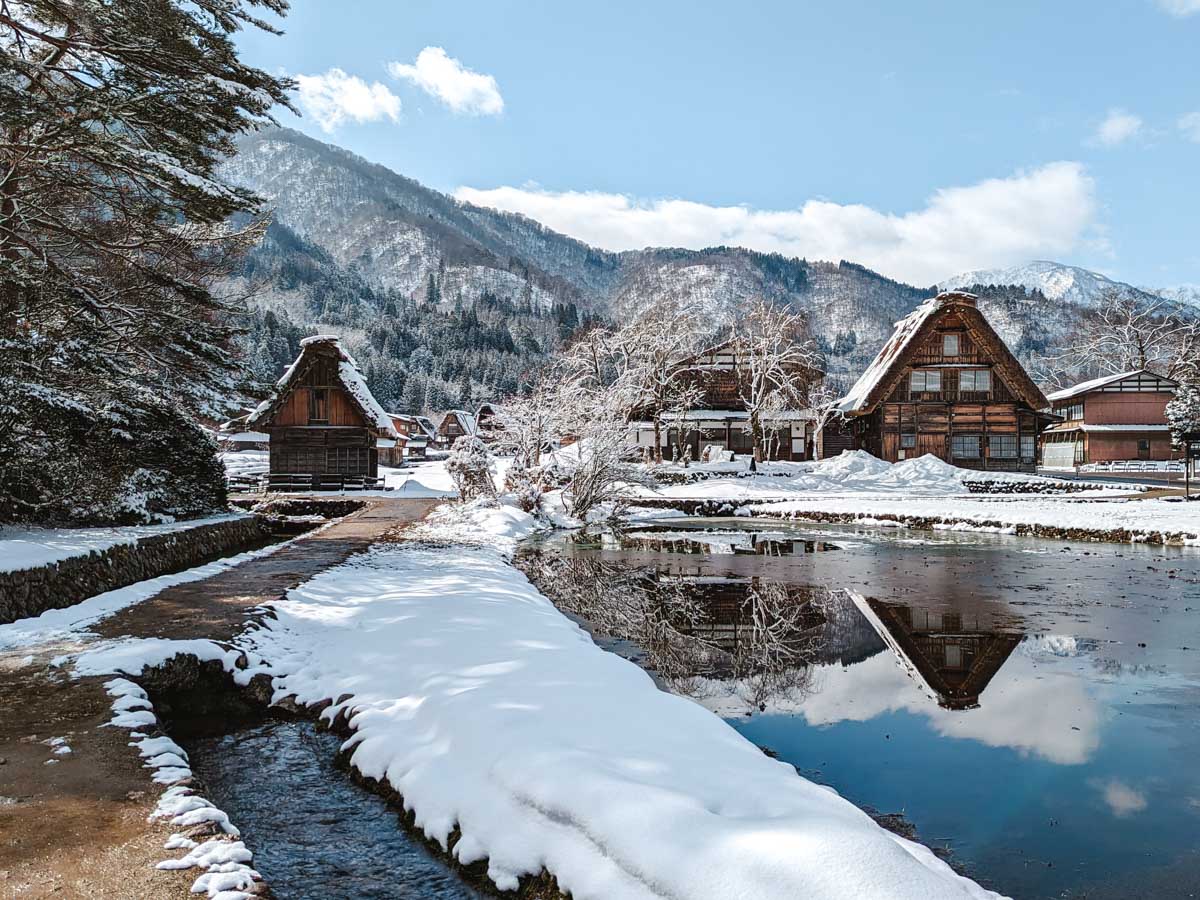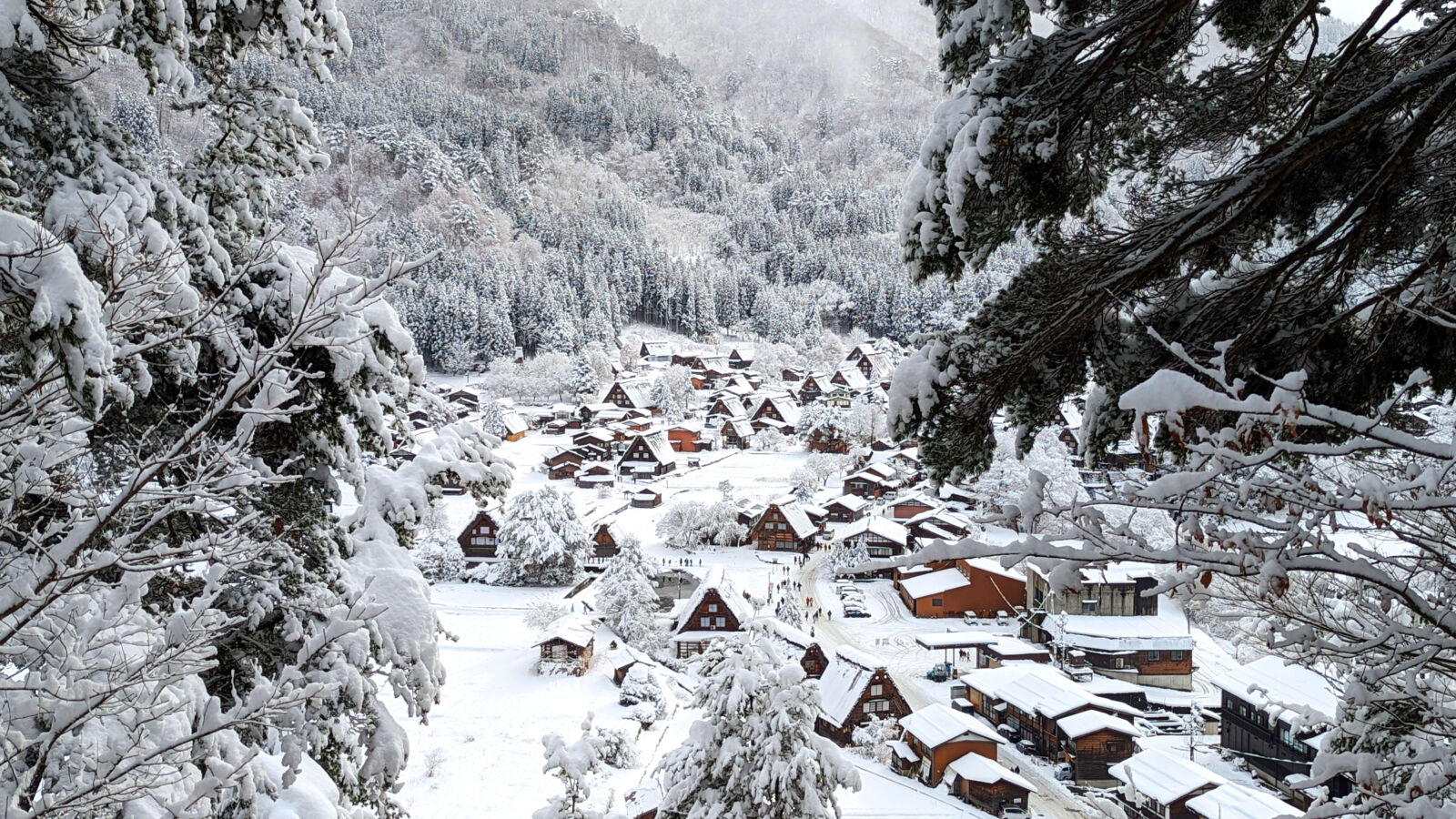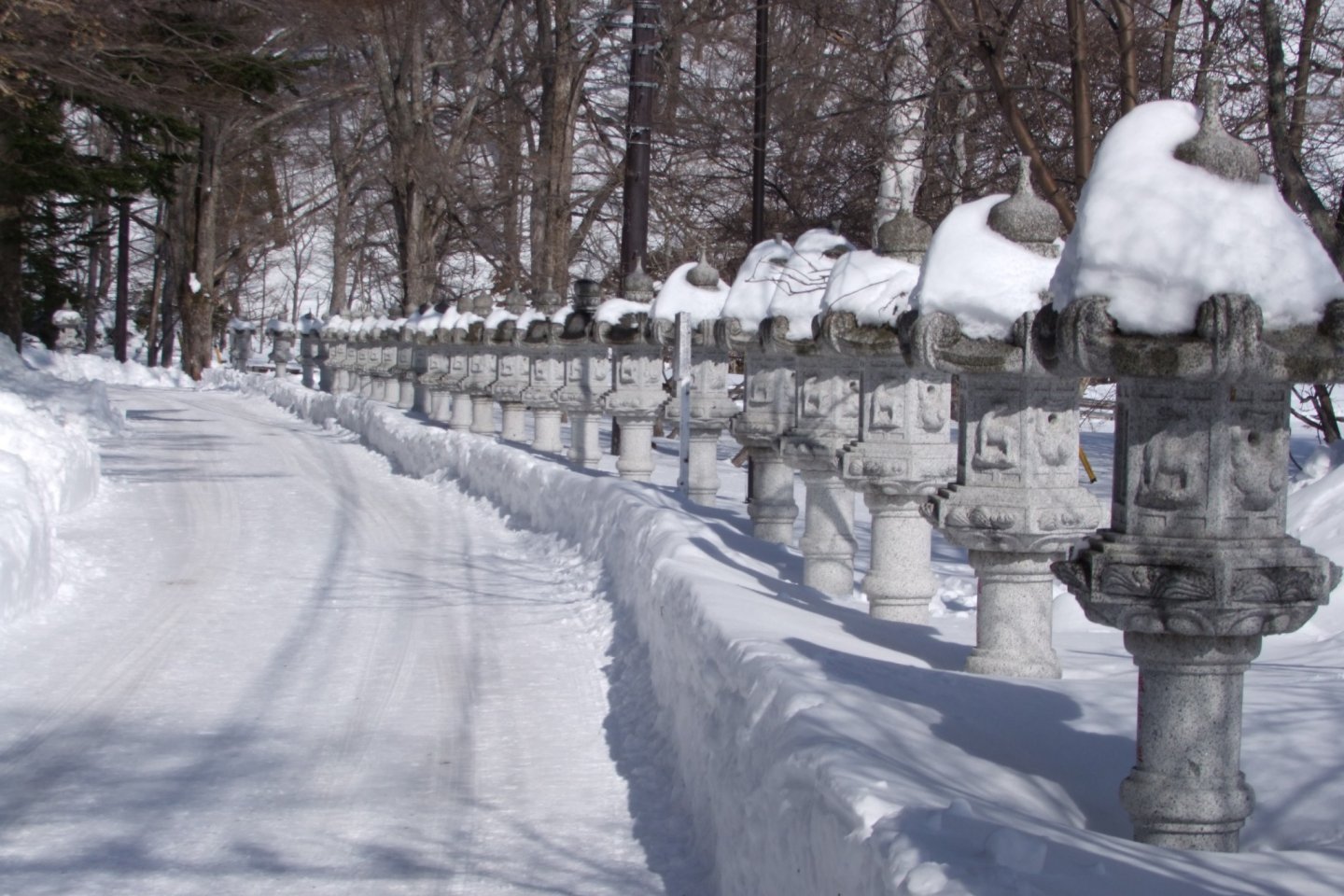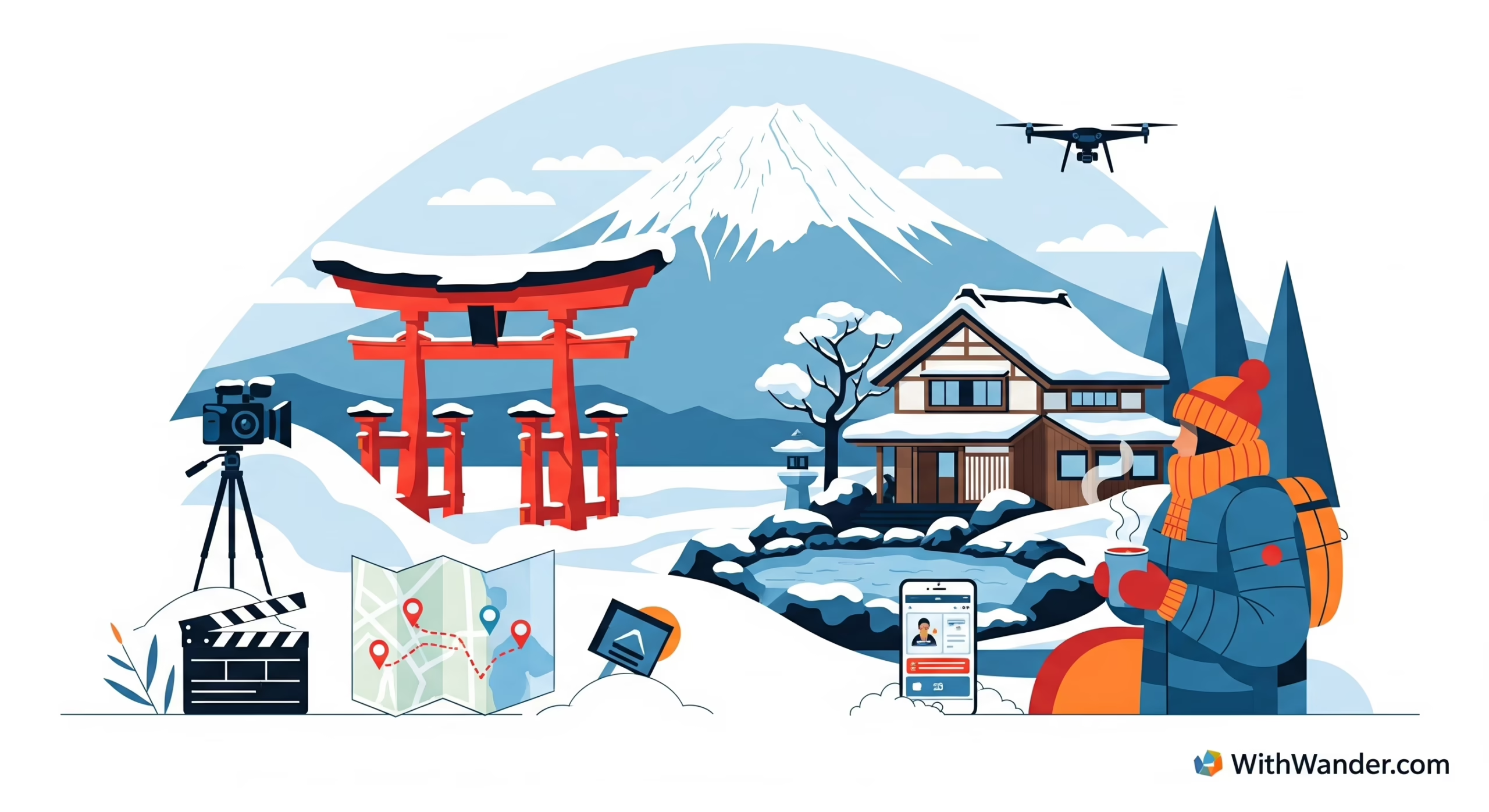INDEX
Filming in Japan during winter is a test of preparation and timing. I once waited for two hours in freezing temperatures near Nikko’s Shinkyo Bridge, just for the snow to fall perfectly.
The resulting shot was worth every second.
This guide is built from experiences like that. It’s for creators looking for the best japan winter filming locations without the usual guesswork.
These specific strategies are part of the broader approach I outline in my complete Japan travel guide. I’ll share five specific hacks covering timing, logistics, and strategy to help you capture Japan’s serene winter beauty.
If your trip happens to start in late November, I’ve also included a quick tip on where to catch the last of the autumn colors.
My Top Japan Winter Filming Locations for Unforgettable Shots

Finding the perfect shot is more than just having a location list. It’s about knowing how and when to approach each place. These are my core strategies for getting footage that stands out.
Each “hack” focuses on a specific challenge I’ve faced, from timing the first snowfall to solving complex travel routes between iconic spots.
💡My Core Filming Philosophy
For winter shoots, always prioritize the “blue hour”—the period just after sunset. In places like Ginzan Onsen, the combination of blue light, orange gas lamps, and white snow is pure magic. This often means staying overnight is non-negotiable.
Hack #1: Mastering the Snowfall in Shirakawa-go

This UNESCO World Heritage site is famous for its gassho-zukuri farmhouses. The key to a great shot here is timing the snow perfectly while avoiding the crowds that pour in from tour buses.
When does it start snowing in Shirakawa-go?
You can expect reliable, picturesque snow in Shirakawa-go from late December through early March. The absolute best period for deep, pristine snow cover is typically from mid-January to mid-February.
For the 2025-2026 season, forecasts indicate near-normal to above-average snowfall conditions, with the possibility of enhanced snowfall if La Niña conditions develop in late winter. I personally aim for the first week of February when the snow is usually at its thickest.
My Filming Strategy for the Ogimachi Village Viewpoint
The classic panoramic shot is from the Ogimachi Castle Observation Deck. Getting there before anyone else is critical. Note that the famous light-up events for 2026 are scheduled for January 12, 18, 25, and February 1, with mandatory advance reservations required.
-
Ogimachi Observation Deck
The main viewpoint. Arrive 45 minutes before sunrise. The walk up can be slippery; bring shoe spikes. Shuttle bus operates 9:00-16:00 every 20 minutes (¥300 one way).
-
Shirakawa Kaido Street
The main village street. Best filmed during blue hour in the evening when day-trippers have left. Access is restricted during light-up events without prior reservations.
Hack #2: Is Ginzan Onsen a Good Day Trip from Tokyo?

While technically possible, I strongly advise against making Ginzan Onsen a day trip from Tokyo if your goal is filming. The travel time is immense, leaving you with almost no quality shooting light.
A day trip gives you maybe two hours in the town during the harshest midday light. To truly capture its atmosphere, which makes it one of the most romantic snowy Christmas destinations, you must stay overnight. Important note: from December 2025 to March 2026, day-trip visitors will be restricted from entering the town between 4 PM and 8 AM to manage overcrowding.
You can technically see the town and say you’ve been there.
It saves the cost of a ryokan for one night.
Fits into an extremely packed travel schedule if you have no other option.
That’s about it, honestly.
Over 8 hours of travel time, round trip from Tokyo.
You’ll completely miss the essential evening and morning light.
The town is most magical when the gas lamps are lit.
It’s a rushed and stressful experience, not good for creative work.
New access restrictions limit day visitors during peak hours (4 PM – 8 AM).
My Recommended Ginzan Onsen Overnight Plan
The most efficient route is via JR Yamagata Shinkansen Tsubasa to Oishida Station (approximately 3 hours 20 minutes, around ¥12,650), then the Hanagasa Bus to Ginzan Onsen (35 minutes, ¥1,000). Buses run approximately every 60-90 minutes, so check the current timetable in advance.
Booking a ryokan in Ginzan Onsen itself can be difficult and costly. My strategy is to stay in nearby Oishida and take the bus in for the evening shoot, or if budget allows, book accommodation in the town itself far in advance.
The iconic ryokan with the red bridge, very photogenic.
Book this one a year in advance, it’s not an exaggeration.
Expect prices starting around ¥35,000-40,000 per person for 2025-2026 season.
The experience and the on-site onsen are top-notch.
Hack #3: Solving the Nikko to Kawaguchiko Transit Puzzle

Many filmmakers want to capture Nikko’s temples in the snow and then get that iconic shot of Mt. Fuji from Kawaguchiko. The logistics of traveling between them can be confusing as there is no direct route.
How to travel between Nikko and Kawaguchiko
The most efficient and practical route is by traveling back through Tokyo. While it seems like backtracking, the train and bus network is so efficient that it’s faster than any alternative. The total journey takes approximately 4-5 hours. Since this often requires an overnight stay, knowing how to stay in Tokyo cheap can save you a significant amount on your budget.
Take the Tobu Railway Limited Express from Tobu-Nikko to Asakusa (approximately 2 hours).
Or take JR Nikko Line to Utsunomiya, then JR Tohoku Line to Tokyo Station.
The Tobu Nikko Pass (¥4,780 for 4-day pass) includes this route and saves money.
Current fare for individual tickets: approximately ¥1,440-2,070 depending on train type.
Direct highway buses from Shinjuku Bus Terminal are the most convenient option.
Book your bus ticket online in advance, especially on weekends. Current fare: ¥2,100-2,300.
The bus ride takes approximately 1 hour 45 minutes in good conditions.
Alternative: Take JR Chuo Line to Otsuki, then Fujikyu Railway to Kawaguchiko (total ¥2,520).
Hack #4: Capturing Hokkaido’s Raw Winter Beauty

For truly unique winter footage, you have to go to Hokkaido. The northern island offers landscapes and wildlife you won’t find on the mainland. It requires more effort, but the payoff is huge.
The cold here is serious. My camera batteries would die in 20 minutes if I didn’t keep them in an inside pocket against my body. Winter temperatures can drop below -20°C (-4°F), and the Japan Meteorological Agency regularly issues weather warnings for heavy snow conditions.
⚠️Extreme Cold Warning
Temperatures in Hokkaido can drop below -20°C (-4°F). Standard winter clothes are not enough. You need thermal base layers, insulated pants, and a proper arctic-rated parka. Frostbite is a real risk for exposed skin. Train and bus services may experience delays or cancellations during heavy snowfall.
Filming Red-Crowned Cranes and Drifting Ice
Two of the most incredible sights are the dancing red-crowned cranes and the sea ice that drifts down from Siberia. The Eastern Hokkaido Express Bus operates special winter routes (February 1 – March 2, 2026) connecting these remote locations.
-
Tsurui Ito Tancho Sanctuary
Near Kushiro. Best spot to film the cranes. Go for the early morning feeding time (9:00 AM) for the best light and activity. A long telephoto lens (300mm+) is essential. Access via JR Kushiro Line to Tsurui Station.
-
Abashiri Drift Ice Cruise
Icebreaker cruise from Abashiri. Current fare: approximately ¥4,500 (2025-2026 season). The ice is most reliable in February. The afternoon cruises (1:30 PM departure) offer the best light for filming.
Hack #5: The Essential Gear & Prep for Winter Filming

Your equipment and clothing can make or break a winter filming trip in Japan. Being unprepared doesn’t just mean discomfort; it means missed shots and potentially damaged gear. This goes for all aspects of your journey, including preparing your house for a long trip before you even leave.
Cold drains batteries fast, keep spares in a warm pocket close to your body.
Acclimate your camera slowly when going indoors to prevent condensation damage.
Use a lens hood to keep snowflakes off your front element.
Water-resistant gear is essential, but a simple rain cover works for lighter cameras.
Layering is key: merino wool base, fleece mid, and a waterproof shell rated for -20°C.
Waterproof boots with good grip and snow chains for icy conditions are non-negotiable.
Get photographer’s gloves with removable fingertips for easy camera operation.
Hand warmers and disposable foot warmers are cheap lifesavers for extended outdoor shoots.
Bonus Tip: Extending Your Trip for Autumn Colors

If you arrive in Japan in late November 2025, you might be able to catch the very end of the autumn foliage season before winter truly sets in. Kyoto is the best place for this, with colors typically lasting into early December in protected areas.
Best places to film autumn colors in Kyoto
For late-season colors, focus on areas with Japanese maple trees (momiji), which often hold their vibrant red leaves longer. Top locations include Arashiyama, especially around the Tenryu-ji Temple garden, and the iconic Kinkaku-ji (Golden Pavilion), where the gold reflects against the red and orange foliage.
🌍Two Seasons, One Trip
I planned a trip for the first week of December once. I spent three days in Kyoto capturing stunning late-autumn reds at Eikando Temple, then took the train north into the snow. It’s a fantastic way to maximize a single trip. Check the foliage reports on the official Kyoto tourism website before you go.
FAQs: Your Questions on Japan Winter Filming Locations

What is the best month to film snow in Japan?
For the most reliable and abundant snow, especially in areas like Shirakawa-go and Hokkaido, February is the prime month. January is also excellent. The 2025-2026 season shows promising forecasts for normal to above-average snowfall.
Do I need a special permit to film in these locations?
For personal use with a small camera and tripod, you generally do not need a permit in public outdoor spaces. However, using large equipment, drones, or filming for commercial purposes requires permits. Drone laws are very strict; check the official regulations from the Japan Civil Aviation Bureau before flying.
Is the Japan Rail Pass worth it for this itinerary?
With the October 2023 price increases (7-day pass now ¥50,000), it depends on your final route. If you plan long-distance travel, like Tokyo to Yamagata and back, or further to Hokkaido, the Japan Rail Pass can still provide value. Use an online JR Pass calculator to input your major train journeys.
How do you get to Shirakawa-go in winter?
The most reliable way is by bus from either Takayama or Kanazawa. I strongly recommend booking your bus tickets online well in advance, especially for travel between January and February, as they sell out quickly. The bus companies have experience with snowy conditions, making it the safest option.
Is it really necessary to book a ryokan in Ginzan Onsen a year in advance?
For the most famous and photogenic ryokans directly on the main street, yes, it often is. My advice is to check their websites for booking opening dates and be ready to reserve immediately. If unsuccessful, staying in nearby Oishida and taking the bus is a practical alternative. Note the new access restrictions for day visitors during 4 PM – 8 AM.
What’s the best time of day to see Mt. Fuji from Kawaguchiko in winter?
Early morning (6:00-8:00 AM) provides the highest chance of a clear view. The air is typically colder and less hazy right after sunrise, meaning clouds are less likely to be obscuring the peak. The low-angle morning light is also perfect for filming.
Is driving in Hokkaido recommended for a winter filming trip?
I would only recommend driving in Hokkaido if you have significant experience driving in heavy snow and icy conditions. For most travelers, it’s safer and less stressful to use the excellent train and bus networks, including the special Eastern Hokkaido Express Bus service (February-March), which connects all major winter filming locations.
What is the single most important piece of non-camera gear for this trip?
A pair of slip-on ice grips (microspikes) for your boots. From the path up to the Shirakawa-go viewpoint to the temple grounds in Nikko, many walkways become slick with packed snow and ice. These cost around ¥2,000-3,000 and are absolutely essential for safety and preventing falls that could injure you or damage equipment.
